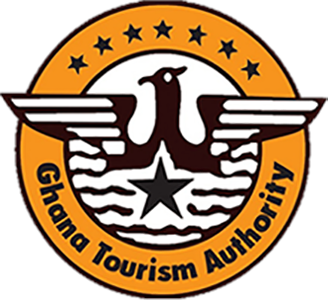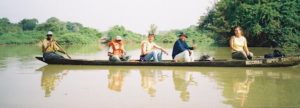This the first episode of KOFI AKPABLI’s (travel writer) Wechiau Adventure
Mission
The vehicle to accomplish the mission was not much; a narrow, 15 foot canoe made of mahogany. After travelling 899 km from Accra, and after countless daydreams and night ones, my moment of truth came when we hit the river. It rolled out vast and as far as the eyes could see.
I was first to face the Black Volta. Behind me, a file of four. These were men I had met for the first time barely an hour ago. But all were playing no small role in the expedition. Sitting directly after me was Agbai Issahaq, my tour guide who was followed by Kassem, the local photographer. Next sat Abdulai, the driver who brought us from Wechiau to the water front at the cost of 20.00 Ghana cedis. At my opposite end was the boatman with the paddle. He is a mere 19 years. Hassan is the lad in whose hands my life rested. I made a mental note to tip him extra after the safari… if I survived.
We cruised at a leisure pace watching banks of savannah forest pass us by. Having quite settled on my piece of seat, I dipped my entire palm in the water and brought it out. The Black Volta felt milky, tasted clayey and smelt odourless. This is the water body that is home to the most famous hippopotamus family in Ghana. It is also international territory. The bank on our left is Ghana and on our right, the Republic of Burkina Faso.
If we continued at our pace for seven days and seven nights, we would appear at Bamboi in the Bole District of the Norther Region. The stretch we were riding is part of the 40 km long Wechiau Community Hippopotamus Sanctuary. Our mission? To spot hippos.
Hippos?
The hippopotamus (Hippopotamus amphibius) is the largest mammal on land, after the elephant. It can weigh up to 4000 kilogrammes – the weight of three saloon cars mashed together. An interesting fact about the hippo is that it is one animal whose species status baffled scientists for a long time. Centuries ago when the Greeks first encountered the creature they named it based on two concepts, hippos meaning ‘‘horse’’ and potamos meaning ‘‘river’’.
But new knowledge later showed how wrong the Greeks were. The hippo does not belong to the horse family. At a point, some naturalists considered it a species of the cow. In fact, the female hippopotamus is still called a cow, its male a bull and the baby a calf. But it was discovered that the hippo is not related to the cow either.
Because of its dental formula, a section of the science community used to believe that the hippo is a type of pig. This view was further supported by the fact that it has a ballooned body supported by short, stocky legs. Again, that also proved to be wrong. As a matter of fact, the closest cousin of the hippopotamus turns out to be the whale.
As we sailed on the trail of the hippo, I could not help but feel an eerie silence. It was the kind of heavy hush that you feel in large, lonely places. It was so quiet, each time a big fish got excited we heard the splash. Meanwhile, the sun, after much hold up by rain clouds, was now showing its presence by shimmering on the water top…
Where is it?
The Wechiau Hippopotamus Sanctuary is located in Wa West District of the Upper West Region. Wechiau, (pronounced ‘‘Wey-chao’’) has since 1999 been one bright community based tourism project. According to local sources, the place got its name from the phrase ‘‘to cut’’ in Wechegii dialect. Oral tradition says that prior to settling in the area, the founders had to cut a mighty amount of forest. Other versions allude the name to a native who was trying his hands at English and instead of saying ‘‘we cut’’ ended up saying ‘‘we chao’’.
Whatever the source of its name, Wechiau has cut a good image for itself as a tourist destination. A glance at the visitors’ book at the reception shows a rich mix of visitors from all parts of the world. Close to Burkina Faso as well as La Cote D’Ivoire, the attraction is a must see for the adventurer who also wants to experience nature and culture.
Side Attraction?
While hippos happen to be the star attraction, there is more to the area. A 300 year old mosque is worth seeing. It was built by Liman-Yiree who came from Kpong in Cote D’Ivoire. There is also a botany walk for those interested in plant life. In addition, the sanctuary is home to monkeys, bats and three species of antelopes.
Wechiau society itself is a fine showcase of how a variety of distinct cultures can exist in harmony. Together, the Wechegiis (Walas), Lobis and Hausas have blended their ways of life, same way as they have preserved their identities.
The Lobis, for instance, enjoy a high standing in international cultural circles. Also found in Burkina Faso and La Cote D’Ivoire, the Lobis are a people who avoided European contact as much as they could. The French, for example, feared them for their poisoned arrow resistance to colonialisation. Thus, very few are the Lobis, who are either Christian or even Muslim.
There is extensive documentation of Lobi sculpture, customs and architecture in world literature. Also known as the Birifor, they are noted for piercing the lips of their women. But that was then. Today, of course, a young Lobi lady would rather have her lips greased with designer lip shine.
As we continued our boat ride, I heard a ‘‘yooo!’’ that rung through the forest. I noticed two fellows standing by the river on the Ghana side. Agbai pointed at a small canoe tied to a tree at the Burkina side. ‘‘They are calling for the boat.’’
The boatman is on the French side, stationed not far from the boat. He would hear the call, row across to the other side and ferry the passengers. It takes about ten minutes and costs 2 Ghana cedis. The equivalent in franc CFA is accepted.
‘‘What if you cannot afford?’’
‘‘You swim’’, replied Agbai.
He was not being sarcastic. Poverty in these parts is a very familiar reality. In the absence of any local industry, the youth here are limited to what their ancestors have always done, catch fish and till the land. The more ambitious among them engage in the ‘‘energy sector’’, that is, burning fuel wood for charcoal.


 Call Center
Call Center
